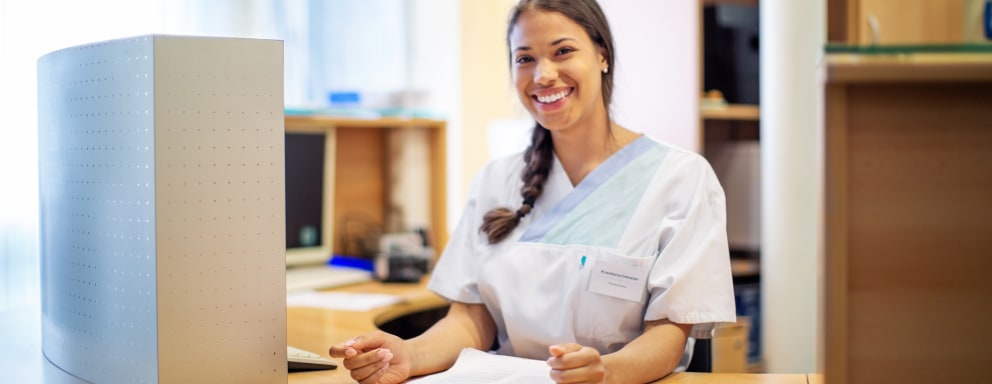5 Things Medical Assistants Learn on the Job
 Credit: Luis Alvarez / Getty Images
Credit: Luis Alvarez / Getty ImagesWhile medical assistants (MAs) learn necessary skills in school, they learn even more on the job. A medical assistant’s duties include administrative and clinical tasks in outpatient clinics, ambulatory settings, hospitals, and doctors’ offices.
The U.S. Bureau of Labor Statistics projects MA jobs to grow 16% from 2021-31, much higher than the average rate for all jobs. The high demand for MAs is related to an increase in older patient populations needing more medical services.
How to Become a Medical Assistant
In most states, there are no formal requirements to become a certified medical assistant. You can be hired with a high school diploma and receive on-the-job training. There are also certificate programs that take about a year to complete and will train you in basic skills.
There are also postsecondary medical assistant degree programs at community colleges that offer an associate degree in about two years. However, with any formal training, you would still need to reinforce the skills learned in a classroom or lab with practical experience.
In an MA program, you learn hard skills such as using medical equipment, taking vital signs, and collecting blood and specimen samples. Soft skills include communication and interpersonal skills.
You can refine your skills with practice. MAs increase their skills through interactions with medical professionals and patients. This experience helps improve their problem-solving, patience, critical thinking, and self-confidence.
MAs can learn hard and soft skills in an educational program, but on-the-job experiences will reinforce and enhance those skills.The following is a list of hard skills you’ll likely learn on the job:
1. Phlebotomy and Specimen Collection
Phlebotomy is also called venipuncture. This is when a needle is placed inside a vein or capillary to collect blood. This skill is part of a medical assistant’s clinical training.
Once out of school, medical assistants can get further education and certification, which is often a requirement for MAs working in a medical lab or hospital.
Being a phlebotomist is an asset and can increase a medical assistant’s salary potential. Hospitals may hire medical assistants who have phlebotomy certification so that they can take blood samples from patients.
D’Vaughn House is a medical assistant at the University of Cincinnati Medical Center Division of Infectious Diseases. He is familiar with the role medical assistants play in collecting body fluids, swabs, and specimens.
2. Clinic and Biohazard Safety
You may or may not have imagined that clinic and biohazard safety is part of a medical assistant’s job description.
Biohazards are substances dangerous to humans, animals, or the environment. The Centers for Disease Control and Prevention group biohazards into distinct categories. Hazardous materials can include viruses, bacteria, fungi, toxins, carcinogens, and allergens.
Most hospitals have a biosafety office that assists health professionals in maintaining a safe environment compliant with regulations.
When you start your medical assistant job, the new skills you learn depend on your work setting and the doctor or nurse you’re working with. House began his career in a research unit. He learned to provide informed consent, collect specimens, and safely process them.
“Regardless of the task, an MA will learn principles of empathy and motivational interviewing techniques to ensure safety and data accuracy,” he says.
3. Administrative Follow-up Skills
Medical assistants play an important role in an outpatient setting. In their administrative role, they use specific knowledge of medical terminology and principles to appropriately schedule and confirm patient appointments. They may also be responsible for :
- Billing
- Processing payments
- Insurance claims
- Writing reports
- Correspondence
However, many medical assistants have crossover duties. For example, with short staffing, if the physician/provider has reviewed and signed off on lab results, the MA may report them to the patient.
House works in a level 1 trauma center where MAs learn how to make those calls and translate medical language into “layman’s terms,” he says.
4. Electronic Medical Recording
Hospitals use electronic medical records (EMR) to record medical information for their patients. The software can also be integrated into the billing software, making it easier to bill insurance companies, Medicare, and Medicaid.
Medical assistants learn how to use electronic medical record systems in school. However, each hospital system will have its own EMR, so medical assistants must also learn each employer’s specific software.
All medical procedures and communications must be recorded. In the case of a medical malpractice lawsuit, if something was not recorded, then it was not completed.
The EMR may also be used with external communication, such as email. This allows patients to contact their doctor which can be automatically recorded in their medical records. Medical assistants help to manage these communications as well.
“During their first year, MAs learn how to collect specific data points like weight, substance abuse history, and medications,” House says. “Upon a patient’s arrival, the MA will create new medical records or update previous encounters.”
5. Efficient Medical Supply Inventory
Hospitals, doctors’ offices, and outpatient clinics must maintain a list of medical inventory. When not properly monitored, it can impact the organization’s efficiency and overburden the staff.
Poor management can lead to an outage of medicines, overstocked supplies, or inadequate disposal of expired medications. It is essential that when a physician orders a test, supplies are at hand.
Medical assistants maintain supplies and check expiration dates. Larger hospitals and clinics may use medical inventory software to improve patient safety. Smaller offices may use a single supply closet. Inventory in offices and outpatient clinics with controlled substances also helps prevent theft.
House points out that efficient supply management skills are essential, whether a medical assistant works in a surgical operating room, primary care office, or outpatient clinic. This is especially important during times when the supply chain is interrupted.
Meet Our Contributor

D’Vaughn House is a medical assistant at the University of Cincinnati Medical Center (UCMC) Division of Infectious Diseases (IDRU) in Ohio. He has been a part of this institution for nearly nine years. Before his work at the IDRU, House worked in the early intervention program at UCMC’s emergency medicine department. His published works include several abstracts aimed at finding novel approaches to HIV testing and prevention in a level 1 trauma hospital setting.
Page last reviewed on December 15, 2022
You might be interested in

Can You Get Your Medical Assistant Certificate Online?
Looking for a medical assistant certificate online? Learn more about these programs and where they can lead.

What Is a Medical Assistant?
Medical assistants enjoy strong job growth projections and satisfying work. This guide describes what they do and how to become a medical assistant.

Ask a Nurse: Can a Certified Medical Assistant Become a Registered Nurse?
Are you a certified medical assistant interested in becoming a nurse? Read below to find out the next steps you need to take.